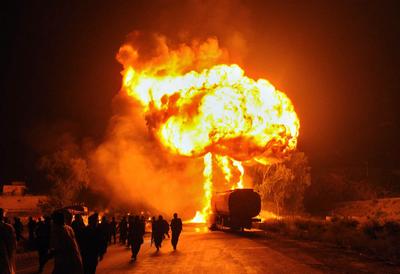After the Sino-US rapprochement in 1972, China, Pakistan and the US were at odds with India and the former Soviet Union. The ‘quadrilateral’ in effect re-emerged as a ‘pentagon’. But the collapse of the Soviet Union in 1991 changed this and opened up the long process of rapprochement between India and the US.
When the US distanced itself from Pakistan after the Soviet withdrawal from Afghanistan in 1989, Pakistan immediately turned to its Chinese and Gulf friends for strategic and financial support. Pakistan and China already had a pre-existing relationship, but it had been overshadowed by Pakistan’s relations with the US. The rise of Wahhabism within Pakistan assisted its relations with the Gulf States.
Now that the US is contemplating its withdrawal from Afghanistan, and its increasingly troubled relationship with Pakistan, Islamabad is again dusting off its China and Gulf options. Some in Pakistan, particularly in the military, want to reassert Pakistan’s policy of seeking strategic depth against India in Afghanistan, where New Delhi is garnering influence through its US$1.2 billion aid program.
So we have the prospect of a South Asia–Indian Ocean region with the US and India drawing inevitably closer, while Pakistan renovates its long-term strategic relationship with China and seeks strategic depth in Afghanistan through its old Taliban links. The four could form the primary relationships of a new ‘quadrilateral’ structure, with a secondary, but still important, set of relationships between Pakistan and leading Gulf States.
But things are rarely this simple. In today’s terms, this ‘quadrilateral’ structure that pertained during significant periods of the Cold War would not provide the participants with the flexibility needed to manoeuvre across the difficult fault lines surrounding Afghanistan.
Pakistan will need to conduct its China relationship against a background of growing tension between the current governing elite and the increasingly influential forces of extreme Islam. These tensions were recently on show with Chinese accusations that the Uighur insurgents-cum-terrorists who mounted a series of attacks in Xinjiang were trained in Pakistan. Although Beijing subsequently backed away from the accusation, the incident illustrates that China would take a very dim view of any Pakistani attempt to revisit its policy of re-establishing the ‘Taliban forte’ version of Afghanistan.
Previously, Pakistan successfully installed a Pakhtun-Taliban regime following a vicious civil war in which there were virtually no other external players. But it is unlikely Islamabad could again reproduce such an outcome in Afghanistan, even if it wanted to. Pakhtuns constitute about 40 per cent of the Afghan population, with the balance made up of Tajiks, Hazaras, Uzbeks, Balochs and others. The non-Pakhtun groups have little incentive to enter into a relationship with Pakistan. Even when the US withdraws from Afghanistan, circumstances this time round are likely to be less conducive to the installation of an outright pro-Pakistan regime in Afghanistan. The government in Islamabad would also be aware that a fully ‘Talibanised’ Afghanistan would likely produce ‘blow-back’ into Pakistan.
So Pakistan’s best option may be to insert itself into the peace process as a key interlocutor in bringing the Taliban to the table. But this means it must continue to support stability in Afghanistan and will be restrained in the way it chooses to support the Taliban.
India also faces challenges in the unfolding scenario. For New Delhi, the worst outcome would be the ‘Talibanisation’ of both Afghanistan and Pakistan. To avoid this, New Delhi may also have to back a compromise, which would involve a voice for Pakistan and the Taliban in any negotiations. The alternative — a total lockout of Pakistan and the Taliban — would risk prolonged war. This would not be ideal for the Americans, who are clearly seeking a way out. And India simply does not have the resources or strategic reach to ‘go it alone’ in Afghanistan. Moreover, any policy that would alienate Islamabad could shut down crucial land and aerial links across Pakistan into Afghanistan, resulting in a significant strategic setback.
The broad shape of a ‘quadrilateral’ is re-emerging, but it is unlikely fully to return to the structure seen during the Cold War. All members of the new ‘quadrilateral’ will want to maintain greater flexibility than that. China will want to avoid a fully ‘Talibanised’ Afghanistan and Pakistan. Instead, it is likely to seek to restrain Pakistan from outright support for the Afghan Taliban. India will have to support US and Western strategies in Afghanistan and ensure that Pakistan is not pushed too far and consequently destabilised. Pakistan cannot fully follow its previous strategy of backing the Taliban against all others, since it could trigger the ‘Talibinisation’ of Pakistan, provoke opposition from China and be unlikely to succeed.
And the US, while having expressed a clear, long-term strategic commitment to India, also requires a ‘judicious compromise’ in Afghanistan so it can leave with dignity and preserve some broader stability in South/Southwest Asia, Which in turn closely affect Gulf stability and provide a bulwark against Iran.
All this, of course, assumes that the present disposition in Pakistan, in which the current military-political elite retains its tentative hold against the Pakistani Taliban and other extremist Islamist forces, remains in place. While greatly desired, this is by no means certain.
Sandy Gordon is a visiting fellow with RegNet at the College of Asia and the Pacific, The Australian National University.
An earlier version of this article was published here on South Asia Masala and here at Future Directions International.

